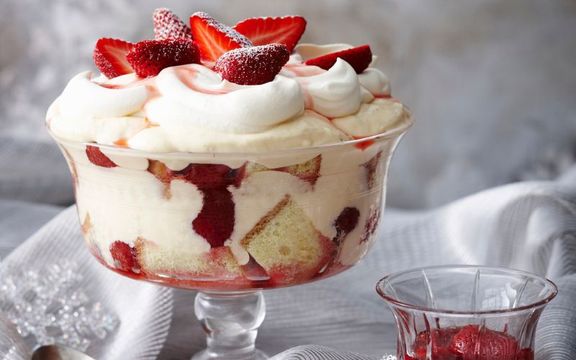
Sherry TrifleGetty
Enjoy this classic assemblage of fruit and cream for your Christmas Day dessert.
"You are too generous to trifle with me,” says Mr. Darcy in his second, more successful proposal attempt in Pride and Prejudice. Our hero uses the word in its purer form, from the middle-English trufe or trufle, meaning “of little consequence.”
Some might say Jane Austen’s work consists of “trifles”—little things of seemingly no importance but, to those involved, deadly serious. She certainly knew the pudding variety—stale biscuits soaked in wine and topped with custard and cream; her sister-in-law, Martha Lloyd’s recipe collection includes a trifle strikingly similar to today’s most English of puddings.
Forever associated with Regency and Victorian cuisine, the dish goes back to Tudor times and beyond. Early versions are simple—lukewarm, thick cream, spiced with then-exotics such as sugar, ginger, and rosewater; today we would add fruit and call it a “fool.”
Read more
The Elizabethans loved fools of the clown variety. They also adored custard, though they were yet to include it in a trifle. A classic Tudor joke was “Almaine Leap,” where a jester would charge into a feast and jump over the guests’ heads straight into a giant bowl of custard. Shakespeare refers to the gag in All’s Well That Ends Well.
The Good Huswife’s Jewell of 1596 carries the first-known trifle recipe, but we have to wait until 1751 and Hannah Glasse’s famous Art of Cookery Made Plain and Easy to find a method we might recognise. Crumbled ratafia or macaroon biscuits were soaked in sack (sweet sherry), covered in custard, and topped with syllabub (frothy, sweetened cream). Later recipes added fruit, jelly and/or jam, and replaced the syllabub with whipped cream. “The higher it is piled,” writes Martha Lloyd, “the handsomer it looks.”
By Victorian times, trifle was a staple for festive occasions, from High Church to children’s parties. The Dean’s Cream at Trinity College, Cambridge included candied fruit and sherry. Eliza Acton’s Duke’s Custard used brandied sour cherries over Naples biscuits.
Fortified wine is, for many, the dessert’s main appeal—British families often tell comic stories about Grandma putting too much sherry in the “whim-wham” or “tipsy cake.” The teetotal movement had its own versions—recipes from the 1860s include Church Trifle (with sherry) and Chapel Trifle (without, using ginger beer or relying on the jelly for moisture).
Sherry trifle has remained popular, not least because it can be easily assembled, at least in the UK, from store-bought ingredients, Made properly, however, it’s sublime. Every family has its own version; each thinks theirs is the correct one. It’s traditionally made in a large, fancy glass bowl, but tends to collapse when cut into. Restaurants, therefore, usually make it in individual dishes which can sadly lead to the proportions being wrong, giving the dish a poor reputation for dryness.
SHERRY TRIFLE RECIPE
Most of this recipe is very easy. Custard can be tricky to make as direct heat often leads to curdling and lumpy “school custard.” A bowl suspended in a saucepan of simmering water should prevent problems. If it does curdle, take it off the heat and beat hard, sieving if necessary. If you can find canned custard, it works just fine. Ambrosia Devon Custard is ideal.
Ingredients:
- 1 stale sponge cake
- 8 tbsp. sherry or other fortified wine. Half-and-half sherry/brandy is good
- 4 oz. ratafia biscuits or sponge fingers (optional)
- 1 packet Jello
- 8 oz. fresh fruit, such as strawberries, raspberries, peaches or plums
For the Custard:
- 1 pint light or heavy cream
- 1 vanilla pod, split lengthways
- 1 ½ oz. superfine sugar
- 2 tsp. cornstarch
- 6 egg yolks
Topping:
- ¾ pint heavy cream
- Confectioners sugar to taste,
- Decoration—to taste, such as flaked almonds, glace cherries, angelica or fresh fruit
Method
- Cut the cake into large pieces and line the bottom of a large (preferably glass) dessert bowl, squashing it to fit. Arrange ratafia biscuits around the walls. Soak with the sherry. Arrange fruit on top, if using. Make up the Jello according to instructions, cool to lukewarm, then pour over the fruit and soaked cake.
- To make the custard, slowly bring cream and vanilla pod to boiling point—don’t allow to overheat. Mix sugar with cornstarch, add egg yolks, one by one, beating until smooth and glossy. Remove cream from heat and vanilla pod from the cream. Pour cream onto egg mix, stirring constantly. Rinse out saucepan, but don’t dry it. Return the mixture to pan and heat gently, stirring constantly until it thickens. Allow to cool slightly, then pour over the fruit/Jello/cake. Cool completely and chill if leaving overnight
- To serve, whip cream with a little sugar, add to the top and decorate with fresh fruit, glace cherries, flaked almonds or however you like.





Comments